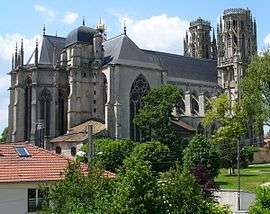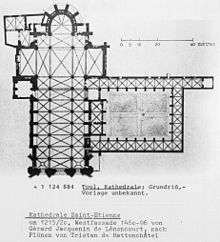Toul Cathedral

Toul Cathedral (Cathédrale Saint-Étienne de Toul) is a Roman Catholic cathedral in Toul, Lorraine, France, and a fine example of Gothic architecture.
It was formerly the seat of the Diocese of Toul, created in 365 and merged in 1824 with the Diocese of Nancy which in 1777 had been formed from the Diocese of Toul. Since 1824 the diocese has been known as the Diocese of Nancy-Toul with one of the biggest cloister in France.
Architecture
The towers of the facade measuring 65 meters high,[1] the nave, 100 m long and a vault height of 30 meters (32 meters before the raising of the pavement) and transept 56 meters wide.
Despite construction on more than three centuries, the building (outside front) has a homogeneity of style. The 13th century saw the construction of the choir, the transept, the last section of the nave and the first row of the gallery of the cloister.
A remarkable element in the construction of the transept is the creation of windows topped with roses that open the transept wall over most of its height. This glass wall effect will be taken at the Cathedral of Metz during the creation of the western facade, a century later and the sixteenth during the reconstruction of the transept as the Basilica of St. Vincent de Metz.
In the 14th century, the four bays of the nave are built.

In the 15th century, the magnificent Gothic façade is built and the first two bays of the nave. In the sixteenth century, two Renaissance chapels were added to the front of the north and south aisles of the nave, the Chapel of All Saints, became the burial of Jean Forget, chaplain and cantor of the chapter of canons, and the chapel bishops with its flat roof coffered, supported by simple low arches - closed for fifty years, awaiting restoration.
The French Revolution made some notable damage (destruction of sculpted figures of the facade). A bombing during the Second World War destroyed the roof and the organ. A major restoration campaign began in the 1980s
Generally the cathedral is a synthesis of the influence of Verdun Cathedral choir for the design of crypt and flanked by towers and facade of Reims for "French" which is also included the idea eardrums glass of the three portals.
The Touloise School
Alain cities in his work on the Toul Cathedral defines the beginning of a school that creates Touloise Gothic style of the thirteenth century which will be largely taken up by land empire in particular via the liebfrauenkirche or 'Franciscan church of Cologne, collegiate-Wimpfen im Tal ...
Other features
Another touloise effect appears when building the broad facade of Flamboyant Gothic style. If the decoration of the towers of the cathedral is probably inspired by those of the Church of St. Martin de Pont-à-Mousson, style bell towers and has definitely influenced the architecture of St. Gengoult college of Toul, which construction was a contemporary of the Cathedral and later at St. Leon church of Nancy neo-Gothic style. The overall structure of the structural façade "to the Reims' but in a flamboyant style of the facade of French style, the façade also be emulated. The clearest influence is on the facade of the Basilica of Saint-Nicolas-de-Port, even if the lines already announced the Renaissance, while the portals of Notre-Dame de l'Épine resumed with the structure gable with a Christ on the cross above the main gate of Toul.
As an influence on the architecture of the area
The Cathedral of Toul is the first Gothic construction started in the land of Empire and, therefore, has obviously influenced many buildings of the Holy Roman Empire, beginning with Lorraine and even Champagne:
- The abbey of St. Vincent de Metz which the whole plan is very similar to that of Toul, although smaller;
- St. Gengoult college of Toul, the site was a contemporary of the cathedral,
- The choir of Notre-Dame-la-Ronde (then included in the Metz Cathedral) follows the plan of the apse of Toul, but without towers this time
- It is the same for the church Sainte-Ségolène Metz which generally takes the cathedral the plan without the towers of the bed, or the Basilica of St. Maurice d'Epinal. Both fit the model of the choir and side chapels opening into the transept.
Chapel of the Bishop
The sublime Chapel of Bishops is an amazing Renaissance chapel whose unique ceiling, flat roof, contains no holding structure. Since the end of World War II, the chapel awaits restoration and reopening in public.[2]
References
Sources
| Wikimedia Commons has media related to Toul Cathedral. |